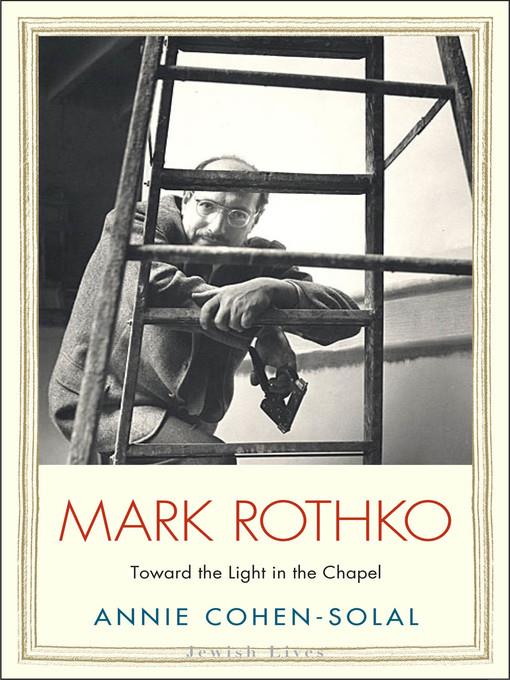
Mark Rothko
Toward the Light in the Chapel
کتاب های مرتبط
- اطلاعات
- نقد و بررسی
- دیدگاه کاربران
نقد و بررسی

Starred review from January 5, 2015
In this gripping biography, Cohen-Solal (Leo & His Circle: The Life of Leo Castelli) examines the life and work of Rothko, an artist motivated by his spirituality and one of the most distinguished painters of the 20th century. The meticulous text begins with the artist’s birth as Marcus Rotkovitch in the Russian Empire in 1903, during a time of “tensions, persecutions, and latent hostility” toward Jews, followed by his emigration to Portland, Ore., at age 10. It goes on to catalogue the political, social, and religious forces that contributed to Rothko’s success and also caused him considerable setbacks throughout his career. Digging into archives and conducting interviews with scholars and the artist’s relatives, Cohen-Solal illuminates the lifelong impact Rothko’s time in Talmudic school, as well as the support he received from the immigrant Jewish community in Portland during his years as a minority student in high school. The author also traces Rothko’s struggles at Yale University, in New Haven, Conn., the “inaccessible club of young WASPs,” where he learned that “the Yale social system was based more on breeding than on merit.” The book richly illustrates a contentious period in the American art world, including the Armory Show, clashes between artists and institutions, and the growing influence of European artists such as Rodin, Cézanne, Picasso, and Matisse in the United States. This novelistic account is a rewarding close-up of Rothko’s personal life and his experience as a Jewish immigrant. Photos.

January 1, 2015
Cohen-Solal's (Leo and His Circle: A Life of Leo Castelli, 2010, etc.) study of Mark Rothko (1903-1970) is notable for her ability to link his strong Jewish ties to his changing, evolving art. Her access to newly available archives enables her comprehensive portrait of the man.Born in Russia, Rothko's father insisted he attend Talmud Torah from ages 4 to 10, after which his family immigrated to Portland, Oregon, and a strong Jewish community. While he quit the temple shortly after his father's death in 1914, his ties to Judaism and his anger at being a minority and an immigrant often obsessed him. He abandoned his scholarship to Yale after two years due to the WASPish exclusion practiced against Jews. The author seems to skip over Rothko's art education; suddenly, at age 32, he has his first solo exhibition in Portland, followed by exhibits in New York and Paris the following year. His style changed often in the 1930s, when he was part of "The Ten," a group of radical, experimentalist individuals rejecting regionalism and searching for the true form of American art. He went from a mythological phase to surrealism to a multiform period. Dissatisfied with realism, he explored "subjective abstraction." When he saw Matisse's Red Studio in 1949, he plunged fully into the realm of abstraction. The artist was always angry, especially at art institutions, which made him hostile and suspicious. They rejected the new American artists and treated his paintings as "decorative." Rothko was obsessive and controlling in exhibitions, but his art conjured emotion out of simplicity; even in the dark, his swaths of color exuded their own light, making his work a complete experience. A sure hit for fans of art history, and readers looking to understand modern art and especially abstraction will find this wonderfully enlightening.
COPYRIGHT(2015) Kirkus Reviews, ALL RIGHTS RESERVED.

Starred review from March 15, 2015
The artist we know as Mark Rothko was born Marcus Rotkovitch in 1903, the youngest child in a secular Russian Jewish family and the only one enrolled in a traditional Talmudic school. This experience, Cohen-Solal (Leo and His Circle: The Life of Leo Castelli, 2010) argues in her tightly focused, profoundly clarifying biography, is the key fact to understanding the life and work of Rothko. With unprecedented access to revelatory archives, a fresh interpretive eye, and a gift for briskly establishing richly textured historical and social contexts, Cohen-Solal tracks Rothko's journey from pogrom-bloody Russia to Portland, Oregon, where, as a precocious high-school student, he protested discrimination against Jews. He went to Yale on a full scholarship but dropped out in disgust over blatant anti-Semitism. In New York, Rothko discovered his artistic calling, forged friendships with similarly radical painters, and took the lead in challenging the stodgy art establishment. Cohen-Solal illuminates Rothko's intellectualism, search for unity, abiding ethics, and the evolution of his purely abstract, transcendentally radiant, deeply emotional, and increasingly spiritual paintings. The first to reveal the secrets of Rothko's elaborate, almost alchemical methods for creating his glowing, contrasting colors, Cohen-Solal also sensitively elucidates Rothko's acute discomfort with success and the depression that led to his 1970 suicide. A defining and affecting tribute to a modern master.(Reprinted with permission of Booklist, copyright 2015, American Library Association.)

























دیدگاه کاربران